Birth and adoption certificates (England & Wales)
There are five registers in England & Wales from which certificates are issued:
- the register of live-births (commonly just called the “birth register”)
- the register of still-births
- the abandoned children register
- the adopted children register
- the Parental Order register (for children born from surrogacy arrangements)
The registers are kept by the General Register Office, and it’s possible to get copies of each kind of certificate.
“Full” and “short” birth certificates
There are two types of birth (or adoption) certificate:
- a certified copy of an entry (a “full” or “long form” birth / adoption certificate)
- a short certificate of birth
Certified copies of an entry (that is — “full” / “long form” certificates)
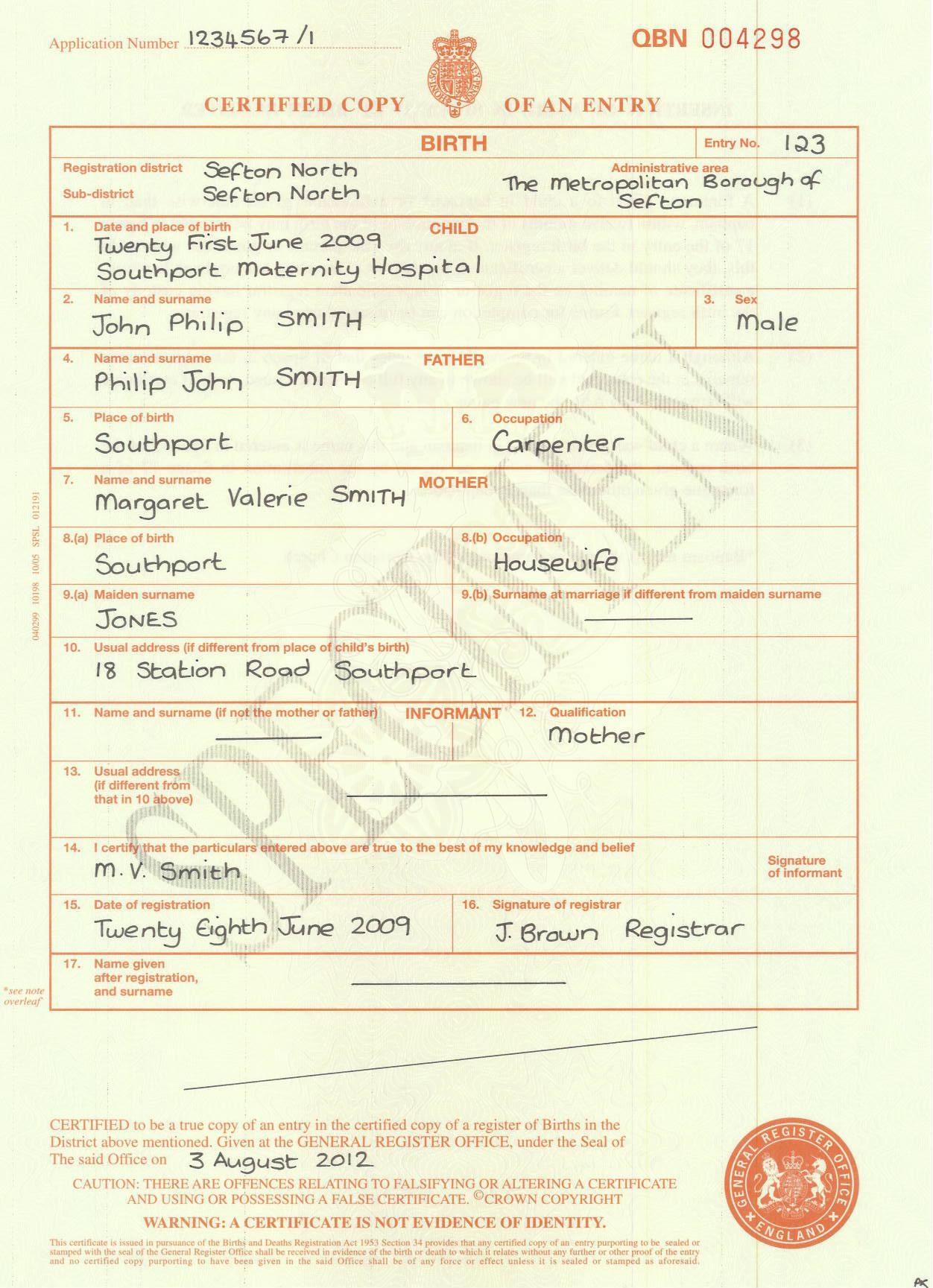
A certified copy of an entry is the proper name for a “full” or “long form” certificate. Despite being known as a “birth certificate” (or “adoption certificate”), at the top it will merely say “Certified Copy of an Entry”.
Certified copies can be issued of an entry in any of the five registers (live-births, still-births, abandoned children, adoptions, and Parental Orders).
Unlike a short birth certificate, a certified copy of an entry will show —
- the mother’s details
- the father’s (or second parent’s) details, if they were recorded
- information about the child’s adoption or having been adopted
This is the type of certificate that is normally requested when applying for a passport, getting married, and so on — because, unlike the “short” birth certificate, it shows your parents’ details and can therefore be used to prove your nationality.
A certified copy of an entry is literally that — it is, more-or-less, an copy of whatever has been recorded in the relevant entry of the register, as held by the General Register Office. For most people, the entry will be as it was made on the day of registration, but it’s possible for annotations or corrections to be made to the entry, including —
- forenames added in baptism or otherwise than in baptism, within 12 months of the birth
- clerical corrections, e.g. spelling mistakes or copying errors made at the time of registration
- the “removal” of the father’s details, if the father is shown not to be the true biological father
- annotations to show that the child was adopted
Short certificates of birth (or adoption)
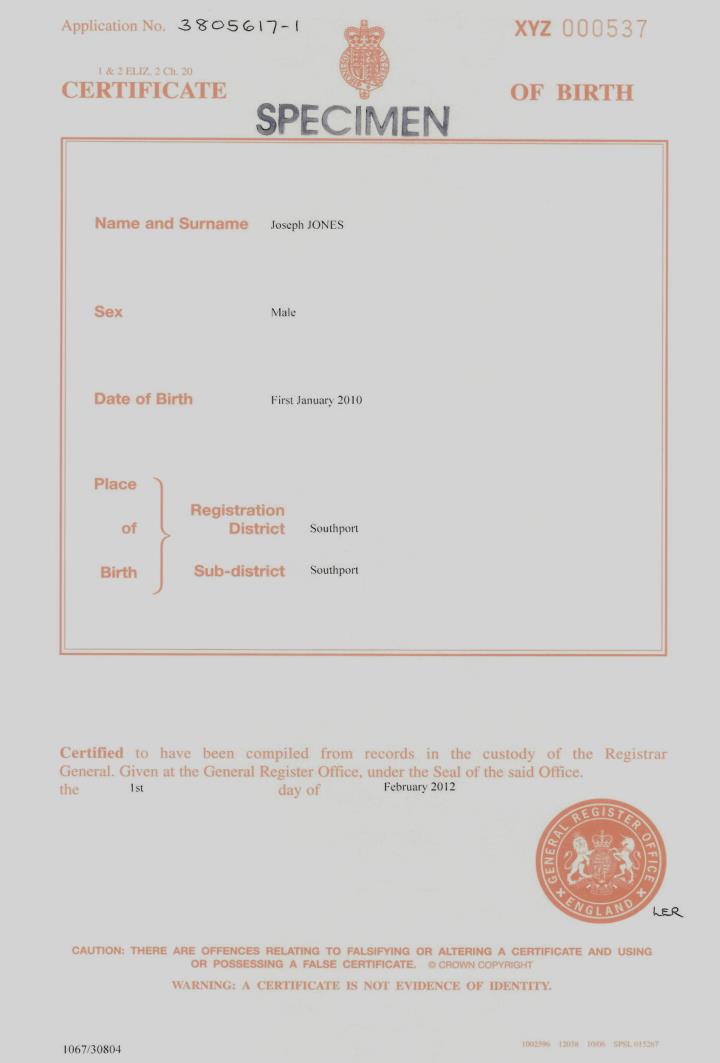
A “short certificate of birth” is the certificate issued for free when you register a child’s birth for the first time, or when you adopt your child.
After that, you can apply for a new short birth or adoption certificate, by furnishing the particulars of the birth (or adoption) as prescribed by regulation 63 of the Registration of Births and Deaths Regulations 1987 , and paying the relevant fee.
Short birth certificates are not really used much nowadays because they do not, generally speaking, prove your nationality — which is needed when you want to apply for a passport or get married.
Your nationality is not shown on, or proven by, your driving licence though, so short birth (or adoption) certificates can still be used to apply for a driving licence.
If you were born before 1983 in the U.K. or any British overseas territory apart from Akrotiri and Dhekelia, you will automatically be a British citizen unless your father was a foreign diplomat or an “enemy alien” during the occupation of the Channel Islands in World War 2. Therefore if this applies to you, then your short birth certificate proves that it’s extremely likely that you’re a British citizen, especially if you were not born in the Channel Islands. Nevertheless, it is the policy of HM Passport Office to request “full” birth certificates for all first-time passport applications.
What’s on a short birth / adoption certificate
A short certificate of birth, for a child born or adopted in England & Wales, is issued under section 33 of the Births and Deaths Registration Act 1953 , and is compiled according to regulation 65 of the Registration of Births and Deaths Regulations 1987 .
A “short birth certificate” and a “short adoption certificate” both come under section 33 / regulation 65 — that is — they are each treated as a “short certificate of birth” — and will show “Certificate of Birth” at the top.
The certificate will show the child’s —
- name and surname (given at the time of birth / adoption / the Parental Order being made)
- sex
- date of birth
- place of birth
The certificate does not show any other details, and will make no reference to any adoption having been made.
Children who have been adopted
If a child was adopted, you can apply for either their short birth certificate or short adoption certificate. The only difference between them will be the name and surname of the child, if a different name was given at the time of the Adoption Order being made.
Section 33 provides that —
(1) Any person shall, on furnishing the prescribed particulars, be entitled to obtain from the Registrar General, a superintendent registrar or a registrar a short certificate of the birth of any person.
(2) Any such certificate shall be in the prescribed form and shall be compiled in the prescribed manner from the records and registers in the custody of the Registrar General, or from the registers in the custody of the superintendent registrar or registrar, as the case may be, and shall contain such particulars as may be prescribed:
Provided that any particulars prescribed in addition to name, surname, sex and date of birth shall not include any particulars relating to parentage or adoption contained in any such records or registers.
Thus a short certificate of birth is not simply an exact copy of the register entry for the birth (or adoption) of a person. The information included on the certificate is “compiled” according to regulation 65 . But importantly, section 33 makes clear that no aspect of the child having been adopted (or of the child’s parentage) can be included on it, even if the “birth certificate” relates to an entry in the adopted children register.
Therefore a “short” adoption certificate (issued under section 33) is nevertheless headed “Certificate of Birth”, and contains no reference at all to the fact of adoption. It is indistinguishable from a “short” birth certificate compiled from the birth register.
A certified copy of an entry on the other hand means a more-or-less exact copy of the birth register (a “full birth certificate”) or adopted children register (a “full adoption certificate”) — including the parent’s details and any annotations relating to (re-)adoption (or a Parental Order).
Full birth and adoption certificates don’t have any restrictions as to particulars relating to the person’s adoption. So if a child has been adopted, their full birth certificate (if issued after their adoption) will be annotated to show that the child has been “Adopted” or “Re-adopted” (which is how their birth register entry will have been marked, according to Schedule 1 of the Adoption and Children Act 2002 ). Their full adoption certificate will contain full details of the date of the adoption order and the name of the court, as well as the particulars of the adoptive parent(s).
If the child’s name was changed at the time of the adoption order being made, the short adoption certificate (and “full” adoption certificate) will show the child’s new name given at that time.
However, to be clear, you cannot normally change the name on your (or your child’s) birth or adoption certificates. Birth and adoption certificates record your name at the time of birth / adoption, and in that sense, it will always be right. The registers (by law) can only be amended in certain circumstances, e.g. if there was a spelling mistake made at the time — but you’ll need to have written proof dated from the time of the birth or adoption to have this done.
Births (that is, live-births)
You can search the indexes of births, and have a certified copy of an entry (i.e. a “full” birth certificate), under the provisions of sections 30–33 of the Births and Deaths Registration Act 1953 .
There is no restriction on you ordering someone else’s birth certificate so long as you don’t do anything fraudulent with it.
The birth certificate will show the mother’s details and, if they are present on the register entry, the father’s details. (The father’s details can only have been registered if — at the time of registration — the parents were married, or both parents jointly signed the birth register.)
It will also show —
- any corrections to the originally registered details (the original, wrong, information will still be visible though)
- if the child has been adopted (in which case it will be marked “Adopted”, and with the country where the Adoption Order was made, if not in England & Wales)
- if the child has been re-adopted (in which case it will be marked “Re-adopted”)
- if a Parental Order has been made with respect to the child (in which case it will be marked “Re-registered by the Registrar General”)
A certified copy of an entry must be issued according to section 34 of the Act, which provides that the certified copy — so long as it has been stamped or sealed by the General Register Office — must be accepted as proof of the details of birth, “without any further or other proof of the entry” being needed.
(You cannot, therefore, ask a solicitor (or some other person) to make a “certified copy” of a birth certificate. The only body that can make “copies” of a birth certificate (that is, which will be accepted everywhere) is the General Register Office itself.)
Still-births
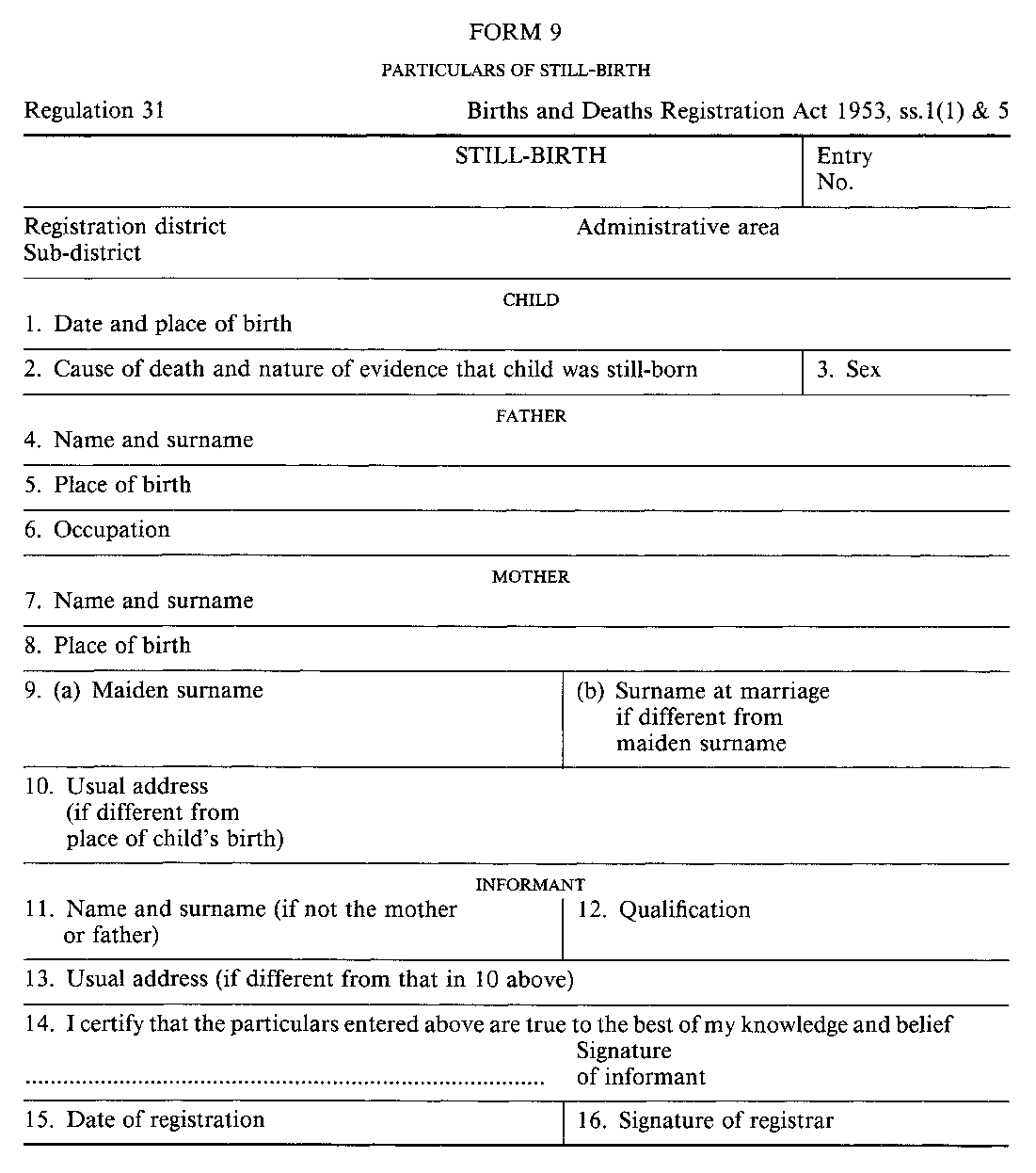
The same rules for searching the index of live-births (and having a certified copy of an entry) also apply to still-births, except that you can only search the index of still-births, and have a full birth certificate (that is, a certified copy of an entry relating to a still-birth), directly from the General Register Office (and not from local register offices) and then only if the Registrar General sees fit — under section 30(3) of the Act.
Generally speaking, only the mother or father of the child is able to apply for a certificate. The parent must be named on the birth certificate to do this. Should the parents be deceased, a brother or sister can apply if they can provide their parents’ dates of death.
You can, nevertheless, order a short certificate of the still-birth, in the usual way — without having the Registrar General’s consent — so long as you furnish the prescribed details of the birth.
Abandoned children
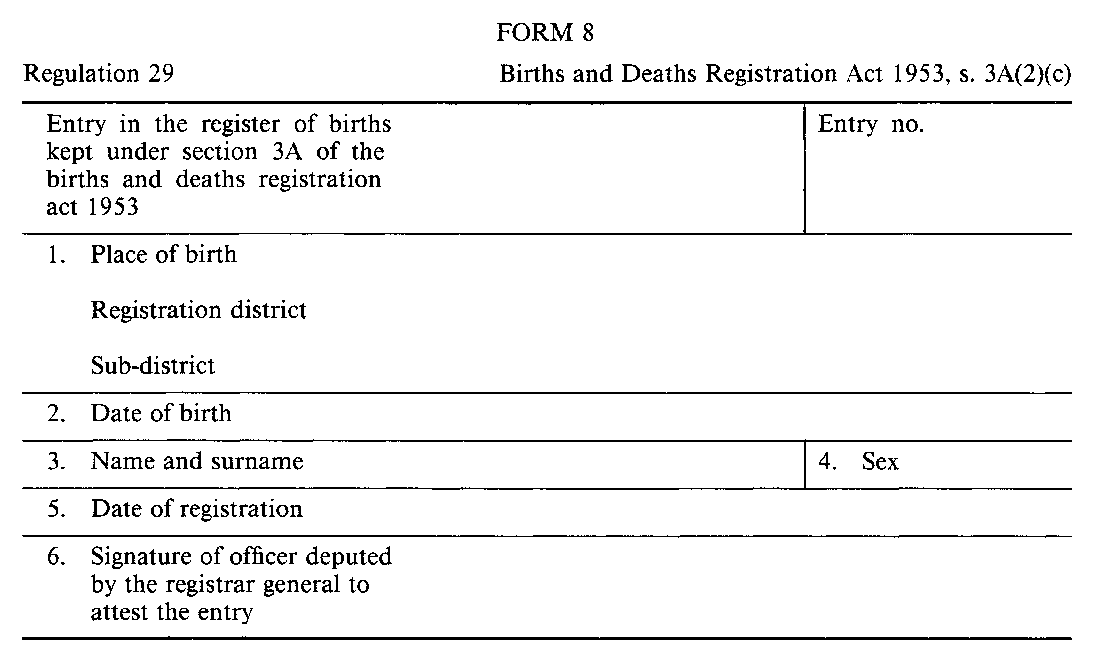
A birth will be registered in the abandoned children register (properly called the “register of births kept under section 3A of the Births and Deaths Registration Act 1953 ”) when —
- the Registrar General is satisfied that the child was born in England & Wales
- the child has not been adopted
- the place and date of birth of the child are unknown
The same rules for searching the index of live-births (and having a certified copy of an entry or short birth certificate) also apply to entries relating to abandoned children.
The only differences are that the birth certificate issued will —
- not show any parents’ details
- not show the details of any informant (the parent(s) or other person who would normally sign the register)
- show the place the child was found or abandoned as their place of birth
- show an estimated date of birth
Adoptions
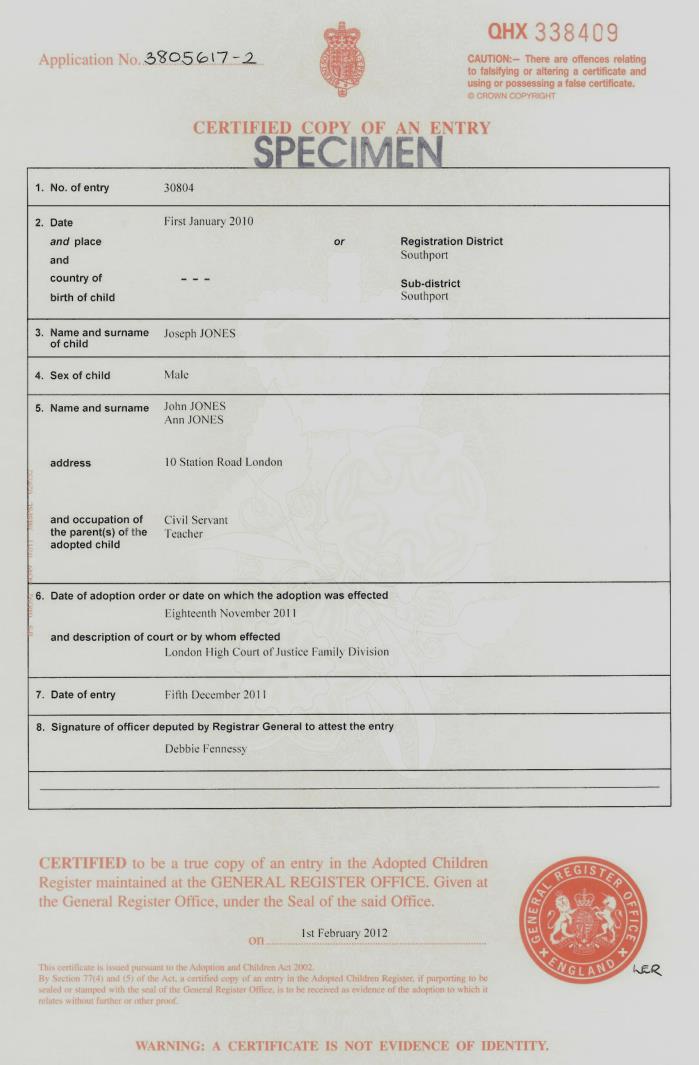
The adopted children register contains the particulars of adoptions authorised by order of a court in England & Wales since 1st January 1927.
A “full” adoption certificate means a certified copy of an entry in the adopted children register, and takes the place, for an adopted person — for all legal and practical purposes — of a “full” birth certificate.
A short adoption certificate is compiled from the adopted children register, but, confusingly, is headed “Certificate of Birth” and contains no reference to the fact of adoption.
An adoption certificate will show only the adoptive details of a person and has no information that relates back to the corresponding birth entry, however only a “full” adoption certificate will make clear that the child was in fact adopted, and that the name and surname is the adoptive name and surname.
The information shown on a “full” adoption certificate includes —
- the adoptive name and surname, that is, the name given at the time the Adoption Order was made
- the date of the Adoption Order, and the name of the court
- details of the adoptive parent(s) (but not the biological parents)
Bear in mind that — even if one of the adoptive parents is also, in fact, a birth parent — their name will be shown as an adoptive parent regardless.
The Adoption Acts have varied in their provisions regarding the inclusion of the country and place of birth in an entry, in that for —
- Adoption Orders made between 1927 and 1949 neither the country, district or sub-districts are shown on a full certificate, as this information is not included in the format of the entry (the country of birth will be shown on a short certificate if it recorded on the court order)
- Adoption Orders made between 1950 and March 1959 the country of birth is recorded on both a full and short certificate
- Adoption Orders made since April 1959, where a person is born in England or Wales, the country, district and sub-district is recorded on a full certificate (the country is not recorded on a short certificate), and where a person is born outside England & Wales, only the country is recorded on both a full and short certificate
Anyone can search the index of the adopted children register, and get a “full” adoption certificate (certified copy of an entry), but you must apply to the General Register Office (and not a local register office), and — if the child is still under 18 — you must furnish the prescribed details , as required by section 78(3) of the Adoption and Children Act 2002 .
Parental Orders
A surrogacy arrangement means that one woman agrees to be pregnant with (and bear) the child of another woman.
In the U.K., surrogacy arrangements are allowed, but they are not legally enforceable. The birth mother is the legal mother of the child and can choose to keep it if she wants to.
Furthermore, if the mother is married, her spouse will automatically become the father (or, if it’s a woman, the second parent) of the child, unless her spouse didn’t consent to her getting pregnant in that way.
Nevertheless, the biological mother or father, together with his/her partner, can apply for a Parental Order, making them the legal parents of the child. The birth (surrogate) mother must agree to this.
When this happens, the child’s birth will be re-registered as an entry in the Parental Order register.
The Parental Order Register
The Parental Order register contains the particulars of Parental Orders made by courts in England & Wales since 1st November 1994.
The “full” birth certificate (certified copy of an entry) based on the Parental Order register supersedes the original birth certificate, and will show only the re-registered details of the person. It has no information that relates back to the original birth entry.
Anyone can search the index of the Parental Order register, and get a “full” birth certificate (certified copy of an entry), but you must apply to the General Register Office (and not a local register office), and — if the child is still under 18 — you must furnish the prescribed details , as required by section 78(3) of the Adoption and Children Act 2002 as applied with modifications by regulation 2 of the Human Fertilisation and Embryology (Parental Orders) Regulations 2010 .

